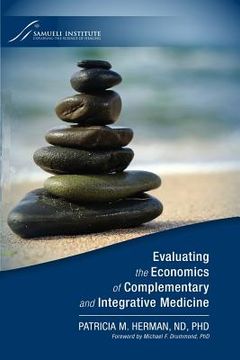Compartir
Evaluating the Economics of Complementary and Integrative Medicine (en Inglés)
Patricia Herman
(Autor)
·
Michael Drummond
(Prefacio de)
·
Samueli Institute
· Tapa Blanda
Evaluating the Economics of Complementary and Integrative Medicine (en Inglés) - Drummond, Michael ; Herman, Patricia
S/ 93,82
S/ 156,37
Ahorras: S/ 62,55
Elige la lista en la que quieres agregar tu producto o crea una nueva lista
✓ Producto agregado correctamente a la lista de deseos.
Ir a Mis Listas
Origen: Estados Unidos
(Costos de importación incluídos en el precio)
Se enviará desde nuestra bodega entre el
Jueves 18 de Julio y el
Lunes 29 de Julio.
Lo recibirás en cualquier lugar de Perú entre 2 y 5 días hábiles luego del envío.
Reseña del libro "Evaluating the Economics of Complementary and Integrative Medicine (en Inglés)"
Healthcare in the United States is expensive and becoming more so every year. Policy and decision makers increasingly need information on costs, as well as effectiveness and safety, in order to formulate health-care strategies that are both clinically effective and financially responsible.Many people believe the benefits of complementary and integrative medicine (CIM) exceed its costs. Surveys have shown that a substantial portion of the US population uses CIM and pays directly for that use.1-4 The most recent estimates show that total US out-of-pocket expenditures for CIM were $34 billion-11% of all US out-of-pocket healthcare expenditures. However, if CIM is to be considered in broader healthcare strategies, its economic impact must be determined.Theoretically, CIM seems a good candidate for cost-effectiveness, and even cost savings, because it avoids high technology, offers inexpensive and noninvasive remedies, encourages healthy lifestyle change, and focuses on the whole person, all of which may improve health beyond the targeted disease or condition. However, to many in the conventional health-care system, CIM is seen only as an "add on" expense. What must be demonstrated via economic evaluation are the healthcare costs that can be avoided through the use of CIM.CIM offers the potential for several avenues of cost reduction. The first is as a direct replacement for the usual conventional therapy for a condition. The second is in terms of lower future healthcare utilization both in general (through treating the whole person) and for the targeted disease or condition. A third avenue to cost reduction is through reducing productivity loss for employers. A reduction in costs to employers does not directly reduce healthcare costs (unless the employer is itself a health-care facility); however, both are costs to society. Productivity losses can be reduced through improved employee health, and potentially through the improved employee well-being and empowerment offered by CIM.
- 0% (0)
- 0% (0)
- 0% (0)
- 0% (0)
- 0% (0)
Todos los libros de nuestro catálogo son Originales.
El libro está escrito en Inglés.
La encuadernación de esta edición es Tapa Blanda.
✓ Producto agregado correctamente al carro, Ir a Pagar.

